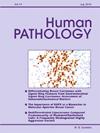转移性乳腺癌中激素受体阳性、人表皮生长因子受体2缺失、超低和低的临床病理特征
IF 2.7
2区 医学
Q2 PATHOLOGY
引用次数: 0
摘要
her2导向的治疗前景正在迅速发展。激素受体(HR)阳性和人表皮生长因子受体2 (HER2)低和HER2超低患者使用HER2定向抗体药物偶联物显示出临床意义的无进展生存改善。在此,我们评估了激素受体阳性(HR+)、HER2 Null、HER2超低和HER2低转移性乳腺癌(MBC)的发生率,并回顾了原发肿瘤的临床和病理方面。我们回顾性回顾了2023年1月至12月期间诊断为HR+/HER2- MBC转移性乳腺癌的所有患者,并以HER2低、超低和零结果为特征。95例患者中99例出现HR+/HER2- MBC。HR+/HER2低MBC 70例(70.7%),HR+/HER2超低MBC 21例(21.2%),HR+/HER2无MBC 8例(8.1%)。原发性乳腺癌的HR和HER2状态在99个样本中有56个(56.6%)可用。原发性和转移性乳腺癌样本在56例中有39例(69.6%)具有相同的HER2状态。2例(4.1%)HER2 Low和1例(33.3%)HER2超低原发性乳腺癌在转移环境中转移到HER2 Null, 3例(75%)HER2 Null原发性乳腺癌转移到HER2超低或HER2低。我们为期一年的单机构回顾性研究显示,大多数MBC为HR+/HER2低,其次是HR+/HER2超低。虽然大多数原发性和转移性乳腺癌样本具有相似的HER2状态,但患者在转移性肿瘤样本中可能会出现HER2状态的变化,并且对转移性样本进行重复生物标志物检测可能会有意义地指导HER2定向抗体药物偶联治疗。本文章由计算机程序翻译,如有差异,请以英文原文为准。
Clinicopathologic characterization of hormone-receptor positive, human epidermal growth factor receptor 2 Null, Ultralow, and Low breast carcinoma in the metastatic setting
HER2-directed therapy landscape is rapidly evolving. Patients with hormone receptor (HR)-positive and human epidermal growth factor receptor 2 (HER2) Low and HER2 Ultralow demonstrate clinically meaningful progression-free survival improvement with HER2-directed antibody drug conjugates. Herein, we assess rates of hormone receptor-positive (HR+), HER2 Null, HER2 Ultralow, and HER2 Low metastatic breast carcinoma (MBC) and review clinical and pathologic aspects of primary tumors. We retrospectively reviewed all patients diagnosed with HR+/HER2- MBC metastatic breast carcinoma between 01/2023-12/2023 and characterized patients with HER2 Low, Ultralow, and Null results. 99 samples from 95 patients showed HR+/HER2- MBC. Seventy (70.7%) patients had HR+/HER2 Low MBC, 21 (21.2%) had HR+/HER2 Ultralow MBC, and 8 (8.1%) had HR+/HER2 Null MBC. HR and HER2 status of primary breast carcinoma were available in 56 (56.6%) of 99 samples. Primary and metastatic breast carcinoma samples shared the same HER2 status in 39 (69.6%) of 56 cases. Two (4.1%) of HER2 Low and 1 (33.3%) of HER2 Ultralow primary breast carcinoma cases showed shift to HER2 Null in the metastatic setting, and 3 (75%) of HER2 Null primary breast carcinoma cases showed shift to HER2 Ultralow or HER2 Low. Our one-year single-institution retrospective study shows majority of MBC are HR+/HER2 Low, followed by HR+/HER2 Ultralow. While majority of primary and metastatic breast carcinoma samples share similar HER2 status, patients may show change in HER2 status on metastatic tumor samples and repeat biomarker testing on metastatic samples may meaningfully guide HER2-directed antibody drug conjugate therapy.
求助全文
通过发布文献求助,成功后即可免费获取论文全文。
去求助
来源期刊

Human pathology
医学-病理学
CiteScore
5.30
自引率
6.10%
发文量
206
审稿时长
21 days
期刊介绍:
Human Pathology is designed to bring information of clinicopathologic significance to human disease to the laboratory and clinical physician. It presents information drawn from morphologic and clinical laboratory studies with direct relevance to the understanding of human diseases. Papers published concern morphologic and clinicopathologic observations, reviews of diseases, analyses of problems in pathology, significant collections of case material and advances in concepts or techniques of value in the analysis and diagnosis of disease. Theoretical and experimental pathology and molecular biology pertinent to human disease are included. This critical journal is well illustrated with exceptional reproductions of photomicrographs and microscopic anatomy.
 求助内容:
求助内容: 应助结果提醒方式:
应助结果提醒方式:


